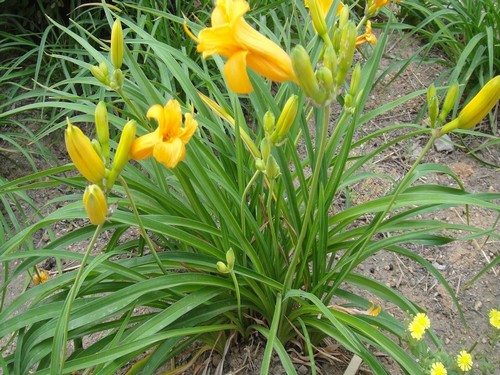Breeding method of Hemerocallis
Hemerocallis is an artificially cultivated horticultural variety of Hemerocallis. Underground with rhizomes and fleshy fusiform tuberous roots. Leaves basal, striate, arranged in two rows, ca. 25 cm long and 1 cm wide. The plant is 30 cm high, the flower is stout, about 35 cm high. Spiral Cymes, 7 to 10 flowers. In landscaping, it is mainly used as ground cover plants, and flower beds and flower borders can also be arranged.
Golden doll Hemerocallis is suitable for popularizing and planting in garden and green space in North China, Central China, East China and Northeast China. Green space dotted with "golden doll" florescence for as long as half a year, and early spring leaf germination, green leaves are very beautiful. In addition, it is not only heat-resistant and cold-resistant, but also has strong adaptability and simple cultivation and management, so it is suitable for planting in urban parks, squares and other green spaces.
Hemerocallis przewalskii can be propagated by tissue culture and plant division. The annual reproduction coefficient of Hemerocallis is generally 1 ∶ 6, and the fertile soil can reach 1 ∶ 10. Ramets can be carried out in the dormant period. Before the beginning of February, the dense clumps of plants in Jiangsu and Zhejiang provinces were cut open with two or three buds in each clump and replanted so that they would blossom in the same year.
Hemerocallis przewalskii is a perennial herb of the genus Hemerocallis in Liliaceae. it is the only multi-season flowering variety of Hemerocallis introduced from North America. The golden doll hemerocallis hemerocallis leaves are bright green, the flowers are golden, and the group ornamental effect is good. In landscaping, it is mainly used as ground cover plants, and flower beds and flower borders can also be arranged.
Hemerocallis przewalskii grows in clusters, with a natural height of 30-40cm, which is the same as that of common Hemerocallis. In spring, the plant sprouts early, the leaf color is bright green, the flower color is golden, and the group ornamental effect is good. It blossoms from the beginning of May to the middle of October, and the flowering period lasts for half a year.
Hemerocallis przewalskii has strong resistance to cold and drought, barren and extensive management. It can survive the winter naturally under the condition of minus 20 degrees in winter in the northern region, and it can maintain normal growth by relying on natural precipitation after planting for two years.
Time: 2019-06-11 Click:
- Prev

Propagation method of Hemerocallis
Hemerocallis is distributed from southern Europe through northern Asia to Japan, but it mainly produces in the Yangtze River Basin of China. It has wide adaptability, like moisture, drought, sunshine and semi-shade. It can grow in general soil, but the sandy loam soil with good drainage and rich humus is the best. Germination of new buds in early spring
- Next

Propagation method of Tulip
Family tulips are generally planted in pieces or more, planted in the garden, every April, flowers bloom in the garden, aroma, looking at other people's tulips, do you envy? According to the following methods, you will also become the envy of others! How to reproduce tulips
Related
- Fuxing push coffee new agricultural production and marketing class: lack of small-scale processing plants
- Jujube rice field leisure farm deep ploughing Yilan for five years to create a space for organic food and play
- Nongyu Farm-A trial of organic papaya for brave women with advanced technology
- Four points for attention in the prevention and control of diseases and insect pests of edible fungi
- How to add nutrient solution to Edible Fungi
- Is there any good way to control edible fungus mites?
- Open Inoculation Technology of Edible Fungi
- Is there any clever way to use fertilizer for edible fungus in winter?
- What agents are used to kill the pathogens of edible fungi in the mushroom shed?
- Rapid drying of Edible Fungi

